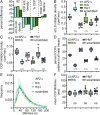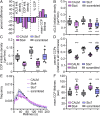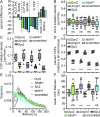Functional characterization of 67 endocytic accessory proteins using multiparametric quantitative analysis of CCP dynamics
- PMID: 33257546
- PMCID: PMC7749282
- DOI: 10.1073/pnas.2020346117
Functional characterization of 67 endocytic accessory proteins using multiparametric quantitative analysis of CCP dynamics
Abstract
Clathrin-mediated endocytosis (CME) begins with the nucleation of clathrin assembly on the plasma membrane, followed by stabilization and growth/maturation of clathrin-coated pits (CCPs) that eventually pinch off and internalize as clathrin-coated vesicles. This highly regulated process involves a myriad of endocytic accessory proteins (EAPs), many of which are multidomain proteins that encode a wide range of biochemical activities. Although domain-specific activities of EAPs have been extensively studied, their precise stage-specific functions have been identified in only a few cases. Using single-guide RNA (sgRNA)/dCas9 and small interfering RNA (siRNA)-mediated protein knockdown, combined with an image-based analysis pipeline, we have determined the phenotypic signature of 67 EAPs throughout the maturation process of CCPs. Based on these data, we show that EAPs can be partitioned into phenotypic clusters, which differentially affect CCP maturation and dynamics. Importantly, these clusters do not correlate with functional modules based on biochemical activities. Furthermore, we discover a critical role for SNARE proteins and their adaptors during early stages of CCP nucleation and stabilization and highlight the importance of GAK throughout CCP maturation that is consistent with GAK's multifunctional domain architecture. Together, these findings provide systematic, mechanistic insights into the plasticity and robustness of CME.
Keywords: CRISPRi screen; GAK; SNAREs; clathrin-mediated endocytosis; total internal reflection fluorescence microscopy.
Copyright © 2020 the Author(s). Published by PNAS.
Conflict of interest statement
The authors declare no competing interest.
Figures






Similar articles
-
Endocytic accessory proteins are functionally distinguished by their differential effects on the maturation of clathrin-coated pits.Mol Biol Cell. 2009 Jul;20(14):3251-60. doi: 10.1091/mbc.e09-03-0256. Epub 2009 May 20. Mol Biol Cell. 2009. PMID: 19458185 Free PMC article.
-
Dynamic early recruitment of GAK-Hsc70 regulates coated pit maturation.Proc Natl Acad Sci U S A. 2025 Jun 3;122(22):e2503738122. doi: 10.1073/pnas.2503738122. Epub 2025 May 27. Proc Natl Acad Sci U S A. 2025. PMID: 40424130 Free PMC article.
-
Understanding living clathrin-coated pits.Traffic. 2004 May;5(5):327-37. doi: 10.1111/j.1398-9219.2004.00187.x. Traffic. 2004. PMID: 15086782 Review.
-
Evolving models for assembling and shaping clathrin-coated pits.J Cell Biol. 2020 Sep 7;219(9):e202005126. doi: 10.1083/jcb.202005126. J Cell Biol. 2020. PMID: 32770195 Free PMC article. Review.
-
Advances in analysis of low signal-to-noise images link dynamin and AP2 to the functions of an endocytic checkpoint.Dev Cell. 2013 Aug 12;26(3):279-91. doi: 10.1016/j.devcel.2013.06.019. Epub 2013 Jul 25. Dev Cell. 2013. PMID: 23891661 Free PMC article.
Cited by
-
Imaging vesicle formation dynamics supports the flexible model of clathrin-mediated endocytosis.Nat Commun. 2022 Apr 1;13(1):1732. doi: 10.1038/s41467-022-29317-1. Nat Commun. 2022. PMID: 35365614 Free PMC article.
-
Mechanistic-Based Classification of Endocytosis-Related Inhibitors: Does It Aid in Assigning Drugs against SARS-CoV-2?Viruses. 2023 Apr 23;15(5):1040. doi: 10.3390/v15051040. Viruses. 2023. PMID: 37243127 Free PMC article. Review.
-
Profile of Sandra L. Schmid.Proc Natl Acad Sci U S A. 2020 Dec 15;117(50):31563-31566. doi: 10.1073/pnas.2022997117. Epub 2020 Nov 30. Proc Natl Acad Sci U S A. 2020. PMID: 33257559 Free PMC article. No abstract available.
-
Intersectin1 promotes clathrin-mediated endocytosis by organizing and stabilizing endocytic protein interaction networks.bioRxiv [Preprint]. 2024 Apr 22:2024.04.22.590579. doi: 10.1101/2024.04.22.590579. bioRxiv. 2024. Update in: Cell Rep. 2024 Dec 24;43(12):114989. doi: 10.1016/j.celrep.2024.114989. PMID: 38712149 Free PMC article. Updated. Preprint.
-
Imaging nanoscale axial dynamics at the basal plasma membrane.Int J Biochem Cell Biol. 2023 Mar;156:106349. doi: 10.1016/j.biocel.2022.106349. Epub 2022 Dec 22. Int J Biochem Cell Biol. 2023. PMID: 36566777 Free PMC article. Review.
References
-
- McMahon H. T., Boucrot E., Molecular mechanism and physiological functions of clathrin-mediated endocytosis. Nat. Rev. Mol. Cell Biol. 12, 517–533 (2011). - PubMed
-
- Kaksonen M., Roux A., Mechanisms of clathrin-mediated endocytosis. Nat. Rev. Mol. Cell Biol. 19, 313–326 (2018). - PubMed
-
- Ehrlich M., et al. , Endocytosis by random initiation and stabilization of clathrin-coated pits. Cell 118, 591–605 (2004). - PubMed
Publication types
MeSH terms
Substances
Grants and funding
LinkOut - more resources
Full Text Sources

